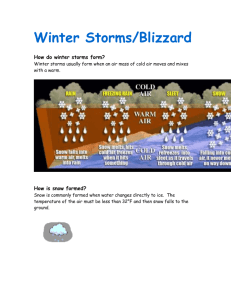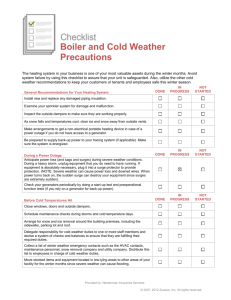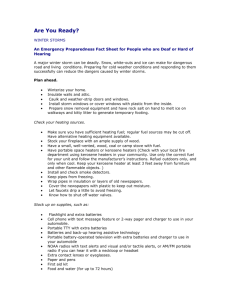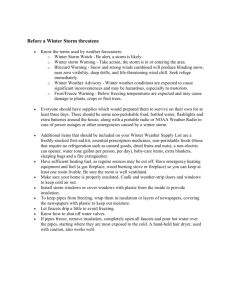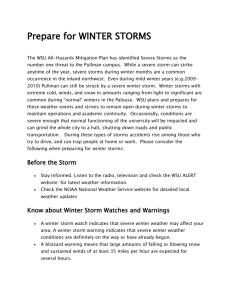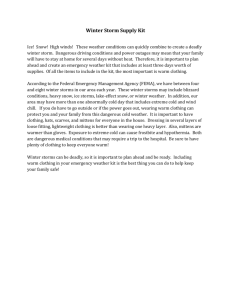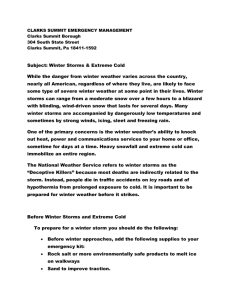Winter Facilities Maintenance By Harry Cheff, Risk Management
advertisement
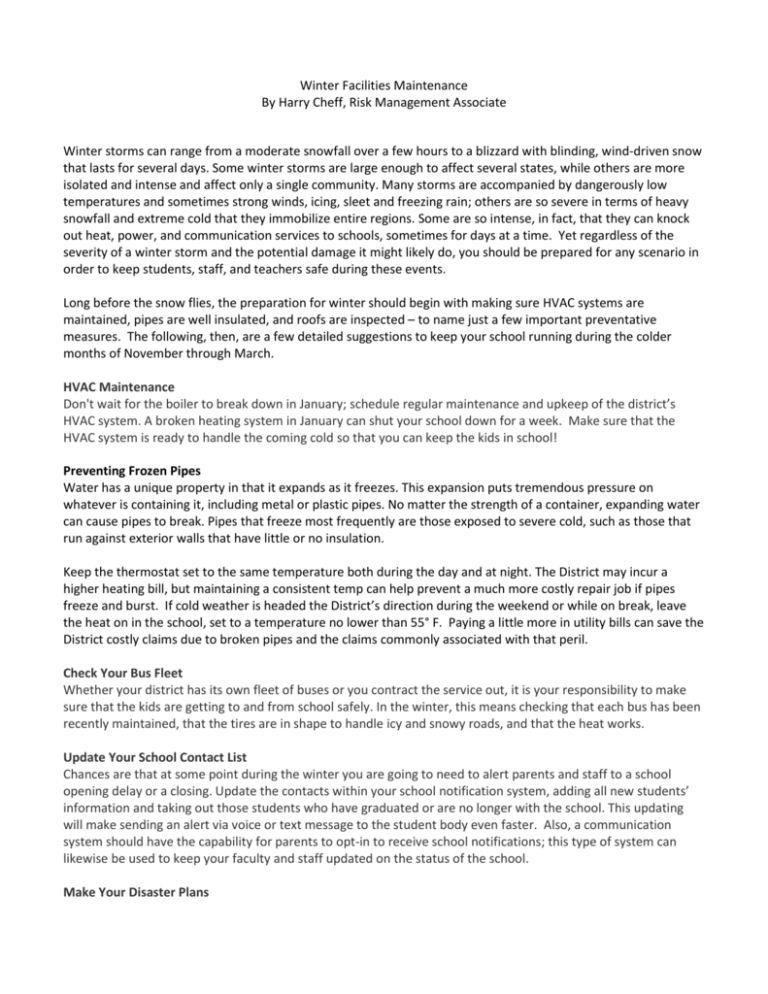
Winter Facilities Maintenance By Harry Cheff, Risk Management Associate Winter storms can range from a moderate snowfall over a few hours to a blizzard with blinding, wind-driven snow that lasts for several days. Some winter storms are large enough to affect several states, while others are more isolated and intense and affect only a single community. Many storms are accompanied by dangerously low temperatures and sometimes strong winds, icing, sleet and freezing rain; others are so severe in terms of heavy snowfall and extreme cold that they immobilize entire regions. Some are so intense, in fact, that they can knock out heat, power, and communication services to schools, sometimes for days at a time. Yet regardless of the severity of a winter storm and the potential damage it might likely do, you should be prepared for any scenario in order to keep students, staff, and teachers safe during these events. Long before the snow flies, the preparation for winter should begin with making sure HVAC systems are maintained, pipes are well insulated, and roofs are inspected – to name just a few important preventative measures. The following, then, are a few detailed suggestions to keep your school running during the colder months of November through March. HVAC Maintenance Don't wait for the boiler to break down in January; schedule regular maintenance and upkeep of the district’s HVAC system. A broken heating system in January can shut your school down for a week. Make sure that the HVAC system is ready to handle the coming cold so that you can keep the kids in school! Preventing Frozen Pipes Water has a unique property in that it expands as it freezes. This expansion puts tremendous pressure on whatever is containing it, including metal or plastic pipes. No matter the strength of a container, expanding water can cause pipes to break. Pipes that freeze most frequently are those exposed to severe cold, such as those that run against exterior walls that have little or no insulation. Keep the thermostat set to the same temperature both during the day and at night. The District may incur a higher heating bill, but maintaining a consistent temp can help prevent a much more costly repair job if pipes freeze and burst. If cold weather is headed the District’s direction during the weekend or while on break, leave the heat on in the school, set to a temperature no lower than 55° F. Paying a little more in utility bills can save the District costly claims due to broken pipes and the claims commonly associated with that peril. Check Your Bus Fleet Whether your district has its own fleet of buses or you contract the service out, it is your responsibility to make sure that the kids are getting to and from school safely. In the winter, this means checking that each bus has been recently maintained, that the tires are in shape to handle icy and snowy roads, and that the heat works. Update Your School Contact List Chances are that at some point during the winter you are going to need to alert parents and staff to a school opening delay or a closing. Update the contacts within your school notification system, adding all new students’ information and taking out those students who have graduated or are no longer with the school. This updating will make sending an alert via voice or text message to the student body even faster. Also, a communication system should have the capability for parents to opt-in to receive school notifications; this type of system can likewise be used to keep your faculty and staff updated on the status of the school. Make Your Disaster Plans Because, as those of us who have shoveled clean our walkways and driveways before heading off to bed know all too well, snow will not only fall during the day but also hard throughout late afternoon and well into the night, it is best for schools to have a plan in place for getting the kids home early if a winter storm during the day is creating unsafe driving conditions for the busses. If you contract your bus services, coordinate your plan with the busing company and make sure that the parents are also aware of the procedure. This is yet another example of an instance wherein having an emergency broadcast system set up can come in very handy. Remove Outside Hazards Winter weather creates hazards that may not be obvious in the fall and spring. Have the gutters around the school cleaned and maintained to avoid icicles building up and dropping down. Also, trim trees near entrances, sidewalks, and wherever students and staff may be walking or standing. The weight of snow and ice may create safety concerns by lowering the branches into a path of foot traffic. Snow Removal Finally, make sure that the District has in place a snow removal plan. This type of plan addresses how snow will be removed from parking lots and sidewalks so that staff can safely travel from their vehicle to the building. The plan should also account for where and when containers of ice melt and sand will be placed near entryways so as to encourage staff to assist in putting down this material to reduce slip and fall hazards due to snow and ice. You need to be ready for when that first storm hits. Don't wait any longer. Start now to make sure your entire school stays safe no matter how hard Mother Nature hits this year. And if the MSGIA staff can be of assistance, please don’t hesitate to contact us. Resources Winter Storm Preparedness by American Red Cross


